You are reading the older HTML site
Positive Feedback ISSUE
september/october 2008
First Impressions: The Playback Designs MPS-5 SACD/CD
Player
by David W. Robinson
[All photographs and image processing by Robinson]
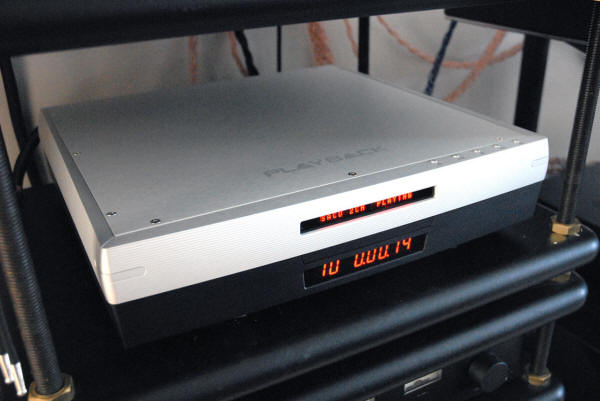
The long and winding road…
It's been quite a few years since I first encountered that remarkable development in audio reproduction: DSD, and its optical outworking, SACD. As I chronicled all the way back in Positive Feedback Vol. 7, No. 6 (Fall 1998), and echoed in Issue 1 of Positive Feedback Online, my trip to Mobile Fidelity's studios in Sebastopol, CA, to hear my first DSD system was a paradigm-altering event. It was the first time that I heard a digital system that I could get really enthusiastic about, and that enthusiasm and conviction has remained, despite all the nonsense and chaos that has melted down much of the media-based distribution chain since that time.
As I think back over the ten years since then, and to all the SACD players that I've heard since then …well, it's a list. I've heard a handful of players from Sony and Philips; I owned the ground-breaking SCD-1 (highly modified by Richard Kern, over time), the SCD-333ES, and the XA777 multi-channel, and the Philips SACD-1000 of dubious fame (but mine still works), modified by EMM Labs to act as a transport for their DAC. In fact, among the players that I've reviewed or evaluated are samples from Linn (Unidisk 1.1), EMM Labs (every version of their product line, in both two-box and one-box configurations), Teac Esoteric (UX-1, X-01, and the DV-60), Marantz (SA-1, SA-12S1, SA-7S1), Accuphase (their original two-box system) Lindemann (the 820), Halcro (the EC-800), Oppo (the 980, with the 983 in the wings), ModWright, Vacuum State Electronics (a couple of levels of their modded players), Tube Research Labs (modified Sony), and APL (modded Teac Esoteric). I didn't write about all of these …some were less memorable to me than others …but I have heard them. And at shows or other listening rooms I've heard worthy work from Cary Audio and Sharp (original SACD player).
In addition to my original experience at Mobile Fidelity, I have gotten to hear MO DSD master discs of original recordings via a Genex professional unit in my own listening room, courtesy of Mike Pappas. I am familiar with Ray Kimber's exceptional master DSD IsoMike™ surround recordings reproduced via the EMM Labs gear used to make them, having listened to his demos at the Rocky Mountain Audio Fest shows. Mike Pappas has also demonstrated some of his DSD surround recordings at that same event, which definitely give you a sense of what the format can do.
On the other hand, I have not heard the SACD players from dCS, Krell, Classé, Ayre Acoustics, mbl, Pioneer Elite, NAD, Denon, the PS3 line of SACD players, and a handful of others. (For a useful recent list of SACD players, see http://www.sacdcentral.com/?cat=3.) In fact, there are so many SACD players that it would take a full-time concerted effort over a long period of time to evaluate them all. The format is far from "dead."
That retrospective summary of the past ten years will give you some sense of what I've honed my SACD evaluation skills on; now let's dig in on the Playback Designs MPS-5 player.
Overview
From the initial launch of the MPS-5, there was a serious buzz about the capabilities of this player. The first accounts on Audio Asylum were intriguing, and were from people who were credible. Providentially, Playback Designs is a brand developed by Blue Light Audio right here in the Portland area, so I was able to arrange a review sample very quickly, courtesy of Jonathan Tinn.
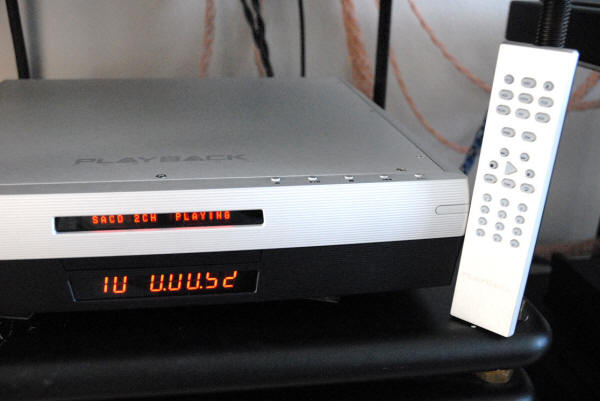
Right out of the box, the evaluation unit's unique look caught my eye. The bold black and aluminum color scheme isn't like anything I've seen from any other manufacturer. I suppose that some audiophiles might not care for the techno-industrial styling, but I thought it to be clean and attractive. Res ipsa loquitur. With its red LED display and blue backlit remote control, the MPS-5 isn't a wallflower; it will definitely draw your attention. I found the track display to be very easy to read at a distance, though I did miss the read-out of SACD disc title and track title listings that some other players (e.g., the very fine Marantz SA-7S1 or the Linn Unidisk 1.1) produce. Then again, the load time on the MPS-5 for SACDs was reasonably quick, being in the neighborhood of 9-10 seconds. (Those of you who, like me, accepted the load time of 27-28 seconds with the Sony SCD-1, know all about patience before the good times rolled ….)
The Playback Designs MPS-5 SACD/CD player is a stereo-only implementation, unlike the EMM Labs CDSD SE/DAC6e SE. (Multi-channel devotees will definitely have to go elsewhere.) It will play SACDs and Red Book CDs that are either 12cm or 8 cm in diameter. Standard CD-R/RWs that are properly finalized may play, but there is the usual caveat that CD-RWs with their lower reflectance may be problematic. Audiophiles are well advised to use only CD-Rs in fine audio players as a general rule. There is no provision for Blu Ray, DVD video, DVD-A, DualDisc, or non-finalized CD-R/RW optical discs.
The I/O set on the MPS-5 is one of its very strong suits. Digital inputs include AES/EBU, which handles up to 192 kHz/24-bit PCM; S/PDIF via standard RCA connector, accepting up to 192 kHz/24-bit PCM; TOSLINK, also accepting up to 192 kHz/24-bit PCM; a proprietary PLAYLINK, which is Playback Designs' ST fiber optic implementation for "future Playback Designs equipment"; PC, which is a USB B connector for USB A (computer) to USB B (MPS-5) cables and PC/Mac connectivity (more on this shortly) with a current resolution of 96 kHz/24-bit on the computer side of things; and AUXILIARY, a 15-pin VGA-like D connector "for future expansion."
Digital outputs feature XLR for AES/EBU (44.1 kHz/16-bit for internal Red Book CD playback; up to 192 kHz/24-bit if being used in as a DAC from AES/EBU digital input from another source); a DATA port for proprietary ST fiber optic "future expansion"; and a proprietary ST fiber optic CLOCK port that is likewise for "future expansion." The reader should note that digital outputs do not function while listening to SACDs, the usual mandated secure logic while listening to DSD sources.
System control includes a USB B connector for updating the MPS-5's firmware via your Windows computer's USB port (there are no current implementations of such software for the Mac); a DB-9 RS-232 serial port for optional control via computer serial port (not recommended, frankly, unless you know exactly what you're doing); and a BOOT button for MPS-5 reset.
Finally, there are the left and right Analog Output sections, with XLR (pin 2 hot), RCA unbalanced, and 50 Ohm BNC connectors.
Overall, this is an excellent I/O set. It allows the MPS-5 to function not only as a stand-alone SACD/CD player, but also as a DAC for an external stereo PCM source at up to 192 kHz/24-bit resolution, and even—via its innovative PC port—as a DAC for computer-based PCM, up to 96 kHz/24-bit streams. If Playback Designs follows through on its promise of developing devices for its ST fiber optical interfaces, then things could get very interesting at the high-resolution end of things, as well.
Those readers who may wonder why there is no HDMI interface need to remember that the MPS-5 is not a universal player with Blu Ray, DVD video, or multi-channel capabilities. HDMI is not required for a platform like this one. The MPS-5 is clearly built to be a no-compromise, world-class reference-grade stereo SACD/CD player, with some flexible capabilities to use its DAC/analog section for other stereo PCM streams.
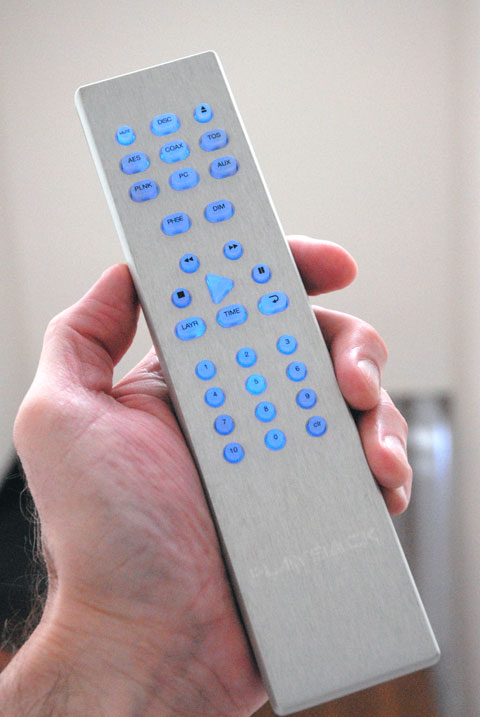
Turning now to the remote control, I'll say that it is a real pleasure to use. It has a metal chassis with a brush aluminum finish, and "PLAYBACK DESIGNS" ghosted below the control set. It gives you a very complete set of functions, including muting, all inputs, phase/polarity (excellent!), front panel display dimming, all the usual track/playback controls, time display toggling (elapsed/remaining track time/total time/total remaining time), repeat mode toggling, numeric track entry, and numeric clear. The only thing that I was missing was the Espresso button to make me some of the true righteous java! Note that the MPS-5 has a manual control set, somewhat unusually placed on the top right of the player. There are small buttons to control open/close, play/pause, stop, back track, and forward track. They worked positively, and are unobtrusive to the look and feel of the design.
The rest of the specifications are simple to state. The MPS-5 measures a squarish, low-profile 17.1" W by 3.5" H x 16.7" deep, and tips the balance beam at a tolerably hefty 29 pounds. Both North American 120V/60 Hz and European 230V/50 Hz models are available.
As a side-note to computer-based audiophiles…
The MPS-5 shows real intelligence in its inclusion of USB 2.0 in its I/O set. If you have computer-based PCM files, it means that you can get double duty from the MPS-5, since it can act as a world-class DAC for music servers and PCM music sources with USB capabilities. There are some things that you need to know, however.
First of all, the MPS-5 supports both Windows PCs and current generation Apple Macs with the following operating systems: Windows 2000, Windows XP, and Windows Vista; Apple Mac OS 9.1, OSX 10.0 or later. Note that the default factory configuration on the MPS-5 is USB disabled, however, to maximize audio quality in other playback modes. In order to have USB plug and play work properly on your computer, you'll need to FIRST select the PC input on the MPS-5 via the remote control, AND THEN plug in the USB cable from your PC. After the MPS-5 has been recognized and configured, you can switch to other inputs freely, and then back to the PC input without a problem. Once you reboot your computer, however, you'll have to go through this process again. This is important to know, since many patch cycles from Microsoft or Apple mandate a boot cycle. I would unplug the USB cable to the MPS-5 in that event, and follow the procedure above once more.
Another very important thing to note is that the audio drivers associated with USB 2.0 port on a Windows box are tied to "mixing" and volume control functions in the digital domain that will compromise the quality of the sound via that port. This is due to the fact that the Windows sound/audio controls are hooked in at the USB driver level. These drivers do not provide the best sound quality, even in Windows Vista SP1. Playback Designs recommends that Windows music servers and Windows XP/Vista SP1 users install the ASIO driver (http://www.asio4all.com) and setting this device as your default audio application. This will bypass all Windows-based internal digital audio processing, and will output a quality feed to the MPS-5. It is very important to note that there are limits to PCM playback resolution via USB 2.0; you'll have to go with AES/EBU, S/PDIF or TOSLINK if you want to achieve 192 kHz/24-bit operation.
The Sound
Playback Designs has obviously set itself the task of building a top-notch, single-box SACD/CD player. The question that we must now ask of such a no-compromise design: has it accomplished its aim?
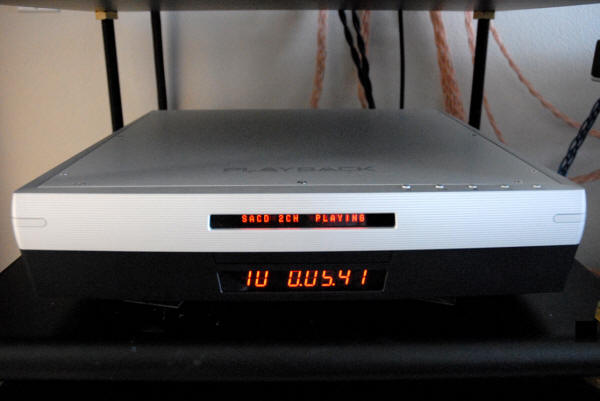
Before starting to describe my listening experience with the MPS-5, I should say something about its transport. Anyone who's dealt with SACD playback knows that the transport and associated engine are an Achilles Heel for many fine audio digital players/transports. (Digression time: this is true of digital playback in general; a sort of "Gresham's Law of Audio"—bad transports driving out good—is in operation. SACD, Blu Ray, DVD video: all wrestle with the economics of transports. These drives are racing one another to the bottom, becoming throw-away items with unbelievable minimum purchase requirements to source them. The result: high-end audio manufacturers can't find superior transports without either having to buy a boat load of them, or pay unacceptable OEM price levels per unit. This is why we see so many SACD players with transports that are rather disappointing, and also why there are some fine audio firms that simply can't afford the really good drives…or won't compromise their standards and risk their reputation on what they can afford. That explains some of the absences at the banquet table of SACD products, which is truly a shame.) There aren't many transports that really stand out in my memory: Linn's CD-12 and Unidisk 1.1, Teac Esoteric's superb VRDS, VRDS NEO, and VOSP line, the Sony SCD-1 top-loader (which ended up in a number of other players, including Accuphase and Cary Audio)…the Lindeman wasn't too bad, though I don't know what transport it was …and that's about it.
The MPS-5 doesn't have a run-of-the-mill-it's-what-we-could-afford cheapo tray, though. Its operation is quiet, silky, positive, and extremely quiet while it is playing. (This is a real problem with lesser transports, some of which are actually noisy enough while playing to be heard during quiet passages in the music. Frankly, this is not acceptable in any transport.) I thought that it seemed familiar, somehow, from the first time that I fired up the unit. It reminded me of the very fine Teac Esoteric VOSP ("Vibration-free Optical Stability Platform") found in the Esoteric DV-60, a transport that I have really come to admire. (For my two-part review of the DV-60, see PFO Issues 34 and 38, at and , respectively.) And as it turns out, I was right. Playback Designs confirmed that they OEM'ed the transport from Teac Esoteric, in a move that I think is really rather brilliant. Far too many SACD players in the world of fine audio have been hampered by inferior transports—but not this one. While that does ramp the price of the MPS-5 up to a cool USD $15K for MSRP, it does also mean that you get a transport that is a joy to operate, and really delivers the musical goods. Some larger firms that I know of have refused to source parts of this quality (or simply can't afford it…or don't want to compete at this consequent price point); I praise Jonathan Tinn and company for taking this step.
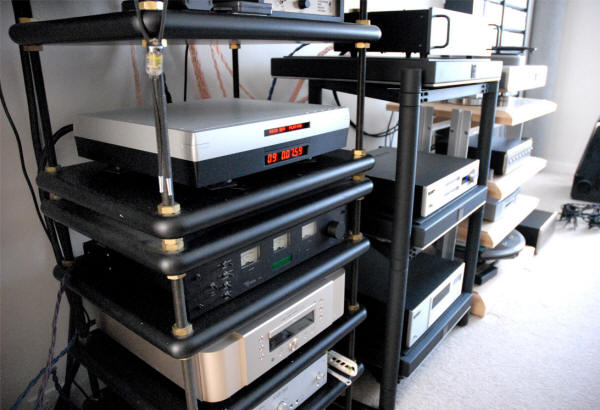
The bold aluminum and black chassis and red display of the MPS-5 mark it out immediately in my listening rack. It's in a great neighborhood here: two shelves down, just under my trusty-rusty Magnum Dynalab is the brushed gold chassis of the Marantz SA-7S1, while on the CMS PXK reference stand next door stands the EMM Labs DCC2 SE DAC/preamp (middle shelf) and the CDSD SE transport (bottom shelf).
I listened to the Playback Designs MPS-5, powered by the amazing JENA Labs Model ONE power cable, in association with the following gear: mbl 6010 D preamp via JENA Labs Symphony XLR interconnects; JENA Labs custom shielded Twin XLR cables to a pair of the mbl 9008 monoblock amps, each with a pair of the Silent Source Music Reference power cables (yes, the 9008 requires two power cords for full power capacity); and then via a bi-wired set of JENA Labs Pathfinder (mid-range/tweeter) and JENA Labs Symphony (woofer) to the superb mbl 101E Radialstrahler omni-directional speakers.
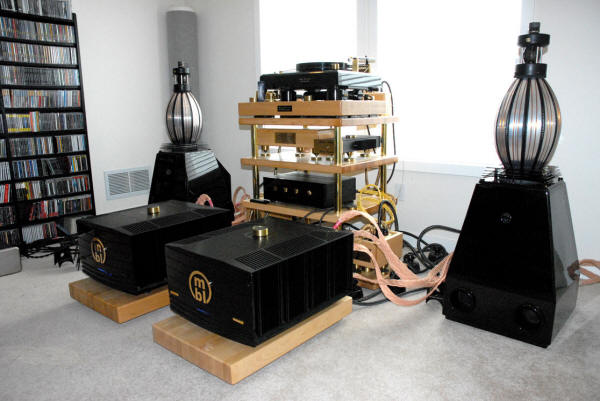
Excellent company for the Playback Designs MPS-5: a superlative mbl assemblage from mbl USA.
While I haven't published my review of the mbl system that was in play while the MPS-5 was under evaluation, I have to say that the results were absolutely stellar. To have access to such a revealing system, one that never lost sight of the music while illuminating every detail of it so clearly, and that synergized so well at every level, out to and including my listening room itself, was a profound audio blessing. It is likely the best complete system that I've had in my listening room. (That's not including the source. Since I haven't heard mbl's new 1622 SACD player yet, I can't tell if they've extended the excellence all the way to the player yet.) The mbl system made my assessment of the MPS-5 much easier, much more pleasant, to do. The MPS-5 arrived after the mbl system had been in place for a while, with my well-known EMM Labs DCC2 SE/CDSD SE tandem as the SACD source, establishing an aural baseline for the new unit.
As usual, I gave the MPS-5 a warm-up with sessions of SACDs for several days before I settled down to listen seriously. I will confess that I cheated briefly, though; I was curious to hear the right-out-of-the-box sound of this ballyhooed unit. And right out of the box, I was very pleasantly surprised. Most players have a problem when they are new, without sound that only shakes out over time. ("Over time" can be anywhere from a few days to over 400 hours, in my experience.) The MPS-5 lacked graininess, constriction, or rolled-off frequencies. It had not fully bloomed, but as it turned out, I found that this happened within a couple of days. The MPS-5 doesn't make you wait long stretches of time to dig into your SACDs; you can be doing that quickly.
Which is what I did.
You've got to remember that I've had the EMM Labs front end in my listening room for years now. This represents the highest benchmark that I've heard, and has taken my annual Brutus awards year in and year out. It would be a bloody stiff test for the MPS-5, no doubt.
The first thing that I noticed, and noticed immediately, was that the MPS-5 extended the mbl system's soundstage depth noticeably, imparting an even greater three dimensionality than I had been hearing. My BMG RCA Living Stereo SACD of Stokowski Rhapsodies, a personal reference recording for hall sound and soundstaging, tonalities, timbre, and orchestral strings, seemed to develop the sort of telescoping near-far effect that Hitchcock did in his camera work in Vertigo, and copied later by Spielberg in Jaws. Near became nearer; far became further away. SACD properly done, like LPs and open reel tapes, have the ability to deliver real "behind the back wall" kind of depth in a well set up stereo system. The MPS-5 was going further in this category than I'd heard before, however. As I listened, it was like moving towards some sort of audiophile holodeck, with the back wall vanishing more or less successfully, depending on the recording. In the case of the Stokowski, the effect was eerie.
That was impressive enough, but even better was the fact that this gain in depth was accompanied by imaging that was rounder than anything I've encountered in SACD reproduction. When listening to Joe Weed and the Vultures, a Top Music SACD that has become a particular favorite of mine, I had a sense that I could just about stand up and put my arms around the members of the band. This is more than the usual sort of "point at the instrument" imaging; I mean that the instruments and performers themselves had a real three-dimensionality. They were not just at an X,Y point, but that I could walk up and put my arm around each one. Pretty amazing, it was.
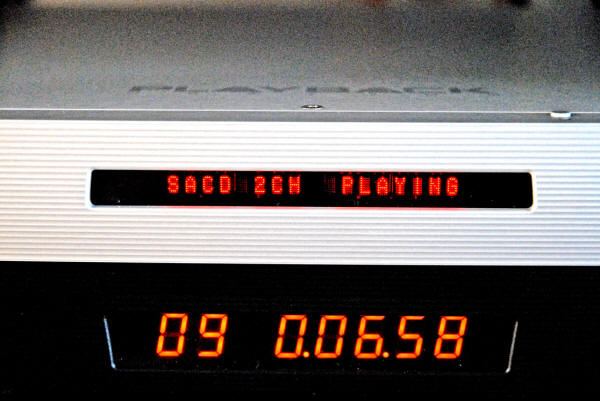
The rendition of musical detail was extraordinary with the MPS-5. It didn't matter what genre I was listening to; any decent recording revealed new nuances that I hadn't noticed before. I spent quite a while listening to SACDs like Mobile Fidelity's reissue of The Byrds' Mr. Tambourine Man (I just love the sound of a Rickenbacker), the SACD reissues of the Depeche Mode catalog, the live Kraftwerk SACD, some of my BIS classical (love that Takemitsu!), JSACDs of Miles Davis …the edge, without any edginess; brilliance of light without blinding glare. This is something that the EMM Labs does well, too, but what set the MPS-5 apart in my mind was its tonal balance. It reminds me of my response to the Lamm M1.2 Reference monoblocks: there was just the right kiss of musicality stirred in with detail. It's not euphonic or romantic …it's just a shading. Exceptional resolution and clarity are there with complete ease, and without sacrificing musical values. That's a tough balancing act to do, and the EMM Labs CDSD SE and DCC2 SE do it extremely well, but it strikes me that the MPS-5 is doing it better.
The dynamics of the MPS-5/mbl combination were exceptional. For example, the swing from whisper quiet to fff on SACDs like the LSO of Sibelius' Kullervo, or the micro- and macro-dynamics of Gorecki's haunting Symphony No. 3 on Naïve SACD were enough to make me want to give a standing ovation at the end of the performance. The BIS SACD of Toru Takemitsu, How Slow the Wind, is always an exceptional experience for me, with subtle tone poems delving into the whispers and waves of creation evoking ever-shifting resonances within me. Bravo! The emotional connection that the MPS-5 made to the mountaintops and the valleys of dynamics were simply the best that I've heard in my listening room.
It's likewise with that all-important audio characteristic for me: transparency. (Another digression alert, here…) I have written about this a number of times before; in my hierarchy of fine audio values, I have come to the conclusion that transparency is that virtue which underlies all others. It embodies purity of signal, a fine audio cleanliness that is next to godliness. It is the degree to which veils are removed during our audio dance, and is affiliate ultimately to what some thoughtful audiophiles would call "accuracy." This is a term that is often misused or misunderstood. I believe that accuracy is a quality that can only be assessed with respect to those ultimate references that I have often pointed to over the past ten years: microphone feeds and master tapes. I think that the ultimate goal that we should be striving for in fine audio can be simply stated: we want to hear in our listening rooms what the original microphone feed sounded like in that original sonic event in history. For better or worse, give me truth; I'll deal with beauty. If we don't like what we're hearing on the mic feed, then we need to fix that; we shouldn't pour treacle on our failures. Away with euphonasia; we have a right to life itself! Anything that impedes the delivery of that original signal is a failure of transparency, a sin against faithfulness and the holiness of the artistic intent, a veiling of the event, a muddying of the waters, and a deviation from the accurate reproduction of what was heard in the sound booth and intended by the artists, the audio engineers, and the producers.
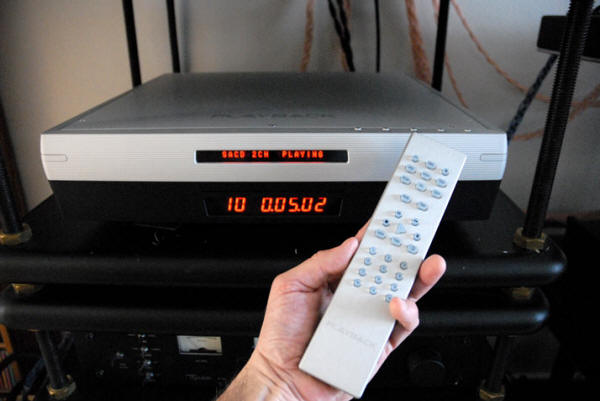
Transparency is the degree to which audio reproduction steps out of the way of the signal, the ability to handle an audio creation without leaving fingerprints all over it. (And with some audio components/systems that I've heard, those fingerprints will be found on the murder weapon, unfortunately.) With DSD and the best SACDs, we are closer to the original event—the original intent—than we've ever been before. And the MPS-5 does the best job of delivering signal without sin that I've ever heard…because the tonality and musical righteousness extends across the entire frequency spectrum.
In this the omni-directional nature of the mbl 101E's mated nicely with the openness, clarity, and presence of the MPS-5 as a source. Having listened to both the EMM Labs and the MPS-5, back and forth (both via XLR, which unfortunately required cable switchovers, since the mbl 6010 D had only one balanced input), I found that both players were very fine in rendering the presence of a hall or studio, but that the MPS-5 consistently had the final word. In every category of audio virtue, what the EMM Labs DCC2 SE/CDSD SE did extremely well, the MPS-5 did better. This is where the unprecedented roundness of imaging, enhanced soundstage depth, resolution and transparency, and tonal balance definitely tipped the balance in favor of the MPS-5 in my book.
I speculate that Playback Designs must have made some significant progress with their algorithms and circuit design…including the analog output sections …for both SACDs and Red Book CDs seem definitely improved over the revision 4 Meitner chipset. Credit for this remarkable improvement in sound goes to Andreas Koch, one of the few real DSD experts on the planet. As a general rule, single box players have some natural advantages over two-box setups, simply because of the minimization of interface transitions and clock issues, and I would therefore expect the MPS-5 to do well. But the EMM Labs SE components with their ST fiber optic interface for clock and data have always been very resistant to jitter anyway. Playback Designs claims that their clock implementation is so well constructed that it does not require master-slave clock setup with external PCM sources. According to Playback Designs, this is due to multi-stage buffering with "unique control algorithms"—again, the accomplishment belongs to Andreas Koch. Zero setup for external (and possibly high-jitter) sources equals complete confidence about internal jitter.
And given what I'm hearing in my listening room, I'd guess that this is not brag—just fact.
Furthermore, and very importantly, the adoption of the Teac Esoteric VOSP drive in the MPS-5 is clearly providing a superior transport for optical discs over the EMM Labs SE series. The drive in the EMM Labs CDSA SE and CDSD SE is probably its weakest point (though some would argue that the ergonomics of the remote control and the front control panel deserve that distinction). For the reasons mentioned above, all fine audio firms wrestle with the transport issue, with only a few (Linn, Teac Esoteric, and now, Playback Designs) coming up with a superior solution. Undoubtedly the OEM use of the Teac Esoteric VOSP transport in the MPS-5 is an important part of the superiority that I'm hearing between it and the EMM Labs SE components.
For the first time, after all these years I've heard an SACD player that betters the Meitner. I didn't think it would happen—but now it has.
Therefore, I must now put the Playback Designs MPS-5 in the place of preeminence, and demote the EMM Labs CDSD SE/DCC2 SE to second place in my audio hierarchy.
Conclusion
As I said in the opening of this essay, the journey for improved digital audio playback via SACD has been a very long road for me. I haven't heard everything in fine audio that handles SACD, but I have heard a lot of what's out there. The EMM Labs CDSD SE/DCC2 SE has been the best of the best to my ears up for years until now, and has been my true reference standard for both SACD and CD sound. It had supplanted my highly modified Sony SCD-1, the Linn CD-12, and all earlier versions of EMM Labs gear, but I have to say that now it has been met—and bested—by the Playback Designs MPS-5.
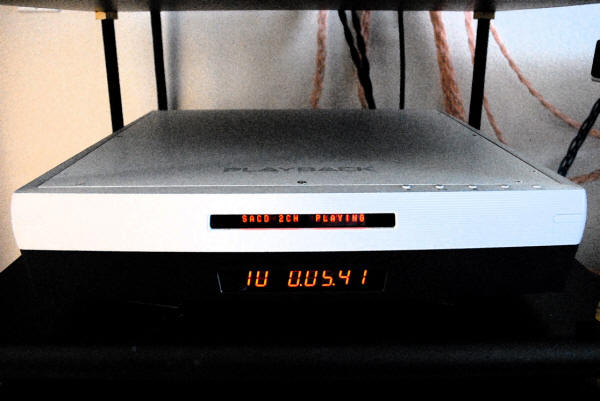
The MPS-5 has it all for a stereo player: a superior transport, an excellent set of I/O ports for flexible use of its capabilities, and above all, the finest quality of SACD and CD reproduction that I've ever had in my listening room. All of this is packaged in a distinctive looking chassis with unique curb appeal, and a remote control that works exceptionally well. I was impressed in every way.
(One final, very important reminder: power cables, isolation, and interconnects DO make a major difference in the performance of all audio components. In making the following evaluation, note that I am recommending the package that includes the JENA Labs Model ONE power cable, the Critical Mass Systems isolation feet (set of four), and the JENA Labs XLR Symphony interconnects.
(The mbl reference system is optional!)
Sooooooo…the MPS-5 now ascends to my personal "top o' the heap" of stereo SACD/CD quality. Kudos to both Andreas Koch and Jonathan Tinn for a wonderful accomplishment; the envelope has definitely advanced with Playback Designs. If you have the scratch, this one will nuke the itch!
I therefore give the Playback Designs MPS-5 a "Ye Olde Editor's Very Highest Recommendation!" with real delight. Here's the new reference standard for me, amigos.
You can draw your own conclusions….
Retail: USD $15,000
Playback Design
Blue Light Audio
4160 S.W. Greenleaf Drive
Portland, OR 97221
Voice phone: 503.221.0465
email address:
[email protected]
web address:
www.bluelightaudio.com/playbackdesigns.html
